|
Night
Safari Walking Trails


Animals
on the Tiger Walkway
|
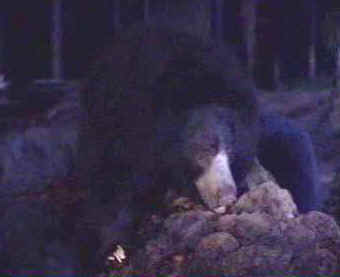
|
Animal
Name: Sloth
Bear
Scientific
Name: Melursus ursinus
Range:
Eastern India and Sri Lanka
Habitat:
Monsoon Deciduous
monsoon forests
Diet:
Insects such as termites
and ants, plus fruits, honey, grains, crops, eggs, small
animals and carrion.
Social
structure: Solitary, except
for females and cubs
Life Span:
Up to 40 years.
Conservation/status:
Widely hunted in the past
and tamed as a performing animal. Even today, up to 100
cubs are taken from the wild each year to be sold and trained
as dancing bears. 70% die before reaching the bear market.
About 2000 still survive in the wild today and is also threatened
by habitat loss.
Remarks:
A very good tree climber.
Has very long front claws for breaking into termite nests,
but causes the bear to walk in a rather awkward manner.
Has a gap between the 2 front incisors to suck out termites
from the nests, helped by its flexible lips and long tongue.
This snuffling noise can be heard from 200 metres away !
|
|
|
Animal
Name: African
Porcupine
Scientific
Name: Hystrix
cristata
Range:
North and northwest Africa,
also found in southern Italy and Sicily (probably introduced
by the Romans), recently introduced to Albania and former
Yugoslavia.
Habitat:
Dry shrub lands, rocky
terrain with plenty of cover.
Diet:
Roots, bulbs, fruit and
cereals
Social
structure: Solitary but
sometimes lives in pairs
Life Span:
Wild - 12 to 15 years, Captivity - A little longer.
Conservation/status:
Not threatened though hunted
by man for food. Young porcupines are preyed upon by big
cats and hunting dogs.
Remarks:
Defends itself in the same
way as the Malayan porcupine, The quills of the New World
porcupines have microscopic barbs on their tips, causing
them to sink deep into an animal’s flesh and painful to
pull out. The quills on the tail can produce a rattling
sound to warn off enemies before the porcupine attacks.
|
|
|
Animal
Name: Serval
Scientific
Name: Felis serval
Range:
Throughout Africa except
in the dense rainforest and driest regions.
Habitat:
Usually live among dense
cover near water areas
Diet:
Small mammals, birds, lizards,
insects and occasionally fish.
Social
structure: Solitary and
territorial
Life Span:
Wild - unknown, Captivity - 19 years.
Conservation/status:
Widespread but elusive.
Hunting pressure and habitat destruction in eastern and
southern Africa have already driven the serval from these
areas.
Remarks:
The only wild cat to hunt
solely by relying on its ears.
The hind legs are longer
then the fore legs, giving it the extra power to jump (in
a graceful arc) onto their prey. They also hide among the
tall grasses and leap up (to a height of 3m) to grab low
flying birds out of the air or dislodge unsuspecting roosting
birds.
|
| |
Animal
Name: Bat-eared Fox
Scientific
Name: Otocyon
megalotis
Range:
Central Africa - southern
Sudan to southwest Tanzania; Southern Africa - Namibia to
central South Africa.
Habitat:
Lives in burrows found
in arid grasslands.
Diet:
Mainly termites and beetles,
but also small mammals, reptiles, scorpions, birds' eggs,
fruit and tubers.
Social
structure: Lives in small
family groups. Adults pair up for life and form strong bonds.
Life Span:
Captivity - 13 yrs.
Conservation/status:
Under threat from habitat
loss. Some are killed by farmers who are unaware that the
small specialized teeth of this fox are not suited for killing
poultry or livestock. Some foxes are hunted for their soft
dense fur during the cooler months when the fur is in prime
condition.
Remarks:
The large ears of the fox
can detect the sound of insects and grubs moving underground
and pinpoint their exact location before it digs them out.
The fox regularly eats scorpions and swallows both the sting
and poison sacs with no apparent ill-effects! Their major
natural predator is the leopard while cubs can fall prey
to jackals and hyenas. A pair of fox parents that are protecting
their young are courageous enough to drive even a marauding
spotted hyena away.
|
|
|
|
Animal
Name: Spotted
Hyena
Scientific
Name: Crocuta crocuta
Range:
South of Sahara in Africa
Habitat:
Open grassland
Diet:
Large prey like zebra,
and antelopes, and carrion.
Social
structure: Live mostly
in clans
Life Span:
Up to 25 years.
Conservation/status:
Widespread in Africa and
not threatened
Remarks:
Makes a characteristic
clown-like laughing sound. Spotted hyenas live in a matriarchal
society where only the females have status in the clans.
The leaders are always female. A large clan of spotted hyenas
can even drive a group of lionesses from their kills but
they tend to be wary if the male lion is present.
|
|
|
Animal
Name: Bongo
Scientific
Name: Tragelaphus eryceros
Range:
Lowland rainforest of West
Africa and the Congo Basin to the Central African Republic
and Southern Sudan
Habitat:
Rainforest with dense undergrowth
Diet:
Browse on leaves
Social
structure: Solitary or
female and young
Life Span:
Conservation/status:
Not confirmed though hunted
by people living near the forest.
Remarks:
First described in the
early 1800s in the jungles of Africa. The most colorful,
most sociable and largest of the forest dwelling antelopes
in Africa. To escape danger, it will dash into dense bushes
and freeze, camouflaging easily due to its striped coat.
Said to to be associated with witchcraft in some remote
parts of Africa though the reasons behind this belief remain
unknown. A certain African tribe believed that it is taboo
to kill and eat bongos. But the superstition is slowly eroding
these days.
|
|
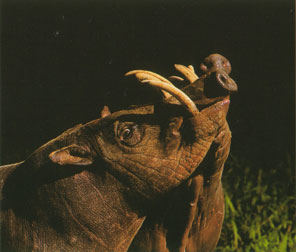
|
Animal
Name: Babirusa
Scientific
Name: Babyruosa bayrusa
Range:
Sulawesi, Togian &
Sulu Islands
Habitat:
Banks of rivers and ponds
of tropical forest, moist forest areas
Diet:
Roots, fallen fruits
Social
structure: Small groups
of up to 8 animals
Life Span:
Conservation/status:
Vulnerable, threats include
poaching by humans for meat and their skulls are sold as
trophies to tourists, loss of habitat due to commercial
logging
Remarks:
Are good swimmers, do not
dig with snouts like other pigs. Only the males have tusks.
The tusks are used to attract females and these tusks grow
continuously throughout their lives. The tusks are the elongated
upper and lower canines. Each male has 4 tusks. The outer
2 tusks grow upwards from the lower jaw while the middle
2 tusks will eventually curve upwards and pierce through
the roof of the upper jaw as they grow. By the time the
males are old, the tusks would have curved backwards and
literally pierce into their skulls, eventually killing them.
What a price to pay for beauty !
|
|
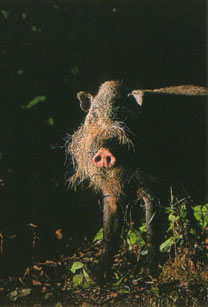
|
Animal
Name: Bearded
Pig
Scientific
Name: Sus barbatus
Range:
Peninsula Malaysia, Borneo,
Indonesia.
Habitat:
Tropical forests and mangrove
thickets.
Diet:
Fallen fruit, shoots, insect
larvae, worms, roots and carrion. It also raids plantations.
Social
structure: Live in large
family groups that can combine with other families to form
even larger groups.
Life Span:
Unknown.
Conservation/status:
Not threatened though it
is hunted by humans for meat. Suffers from loss of habitat
in some areas due to commercial logging.
Remarks:
Called the 'bearded pigs'
because both the males and females possess bushy 'beards'!
These large wild pigs feed on almost any edible thing that
they can find on the forest floors, literally taking on
the roles of 'vacuum cleaners' of the rainforests ! Will
undertake annual migrations where herds of up to 200 members
travel along the same migratory routes in the forests in
search of more food. During this time, they become easy
to ambush by both predators and human hunters.
|
|
|
Animal
Name: Anoa
Scientific
Name: Bubalus Depressicornis
Range:
Confined to lowland forests
of North Sulawesi
Habitat:
Swampy lowlands
Diet:
Grass
Social
structure: Solitary or
at most in pairs, territorial
Life Span:
Conservation/status:
Endangered
Remarks:
The world’s smallest buffalo
and its small size helps it to live easily in dense forests.
The short horns point backwards so they do not get caught
in the bushes when the anoa flees through the forests from
danger. It seems to be one of the most dangerous animals
to handle in captivity.
|
|
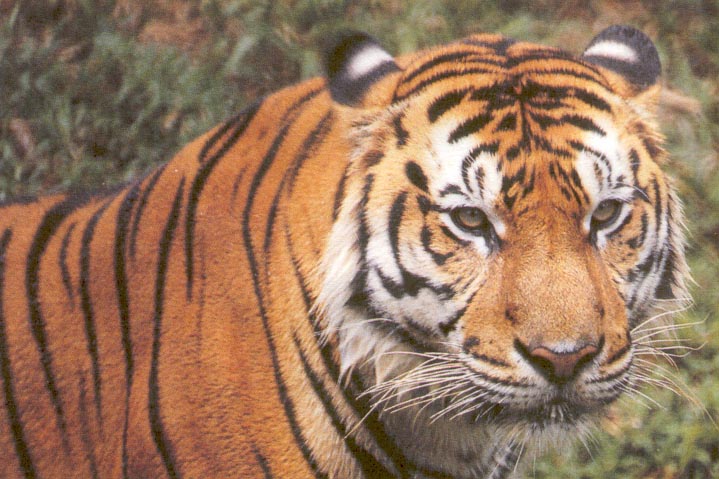
|
Animal
Name: Malayan or Indo-chinese
Tiger
Scientific
Name: Panthera tigris
tigris
Range:
Peninsula Malaysia (though
more known as the Indochina tiger)
Habitat:
Dense forests
Diet:
Deer, monkeys, wild boar,
wild cattle and sometimes livestock.
Social
structure: Solitary
Life Span:
10 - 15 years
Conservation/status:
Highly threatened, hunted
for fur; body parts and bones for Chinese medicine (believed
to cure certain ailments and contain aphrodisiac values);
and suffer from loss of habitat.
Remarks:
3 of the 8 subspecies of
the tiger are already extinct, all the remaining 5 are currently
under threat. Contrary to what most people believe, tigers
are the largest big cats, not lions. Lions seem bigger because
of their manes. An estimated 7,000 tigers are left in the
wild today and extinction is possible by the year 2010 if
current threats persist.
Learn
more about tigers here.
|
|
Animals
on the Forest
Giants Trail

Several
species of free ranging and truly native animals of Singapore
can be seen along this trail but one has to be very observant
and extremely lucky to encounter them. Some possible animals
to see in these forests are the
Colugo (flying lemur), Pangolin (scaly anteater), Slow Loris
and Binturong. The more commonly
seen creatures are the little native fruit
bats. A few nocturnal bird
species can sometimes be heard, like the 'chook chook' sound
of the Nightjar
and the peculiar 'whoooooot' call of the Scops
Owl(?). Then there are of course
the melodious chorus of the elusive crickets
and bullfrogs;
and the frantic piercing sounds
of the cicadas,
most prominent during the rainy nights.
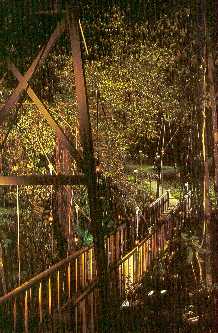
The
highlight of the Forest
Giants Trail is
this amazing 35m
long Bridge of Suspense,
which
overhangs a jungle ravine and
a tiny forest stream. Standing
in the middle of this shaky bridge, one can truly embrace
the magic of Night Safari and its wilderness.
Acknowledgements
- Animal
Facts from Wildlife Fact
Files, classroom
sessions and informal interviews with zoology staff of WRS,
Photos
from Night Safari.
|
Let's
go to the another trail, choose one!
Fishing
Cat Trail
Leopard
Trail
Home
| Explore
| Rangers’ Station
| Walking Trails
| Tram Ride
| Resources
|
©
2009 NSRangers.Tripod.com. All rights reserved.
|
|